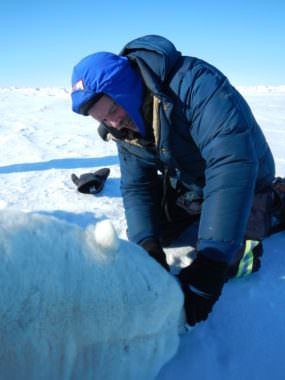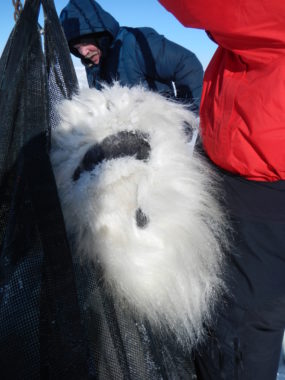
Scientists travel into the Arctic every year to study polar bears. It helps them estimate the population. But this year, they had to cut that research short. Melting sea ice is making the task a lot more difficult.
Michelle St. Martin flies as far as 100 miles off the coast of the Chukchi Sea, looking for polar bear tracks or blood splatters on the ice.
“Seals, ice seals are their number one prey item,” St. Martin said.
St. Martin is a wildlife biologist with the U.S. Fish and Wildlife Service. Along with her team, she sedates the polar bears before taking samples, weighing them and removing a small tooth from each bear: a way for the scientists to determine the age of the animal.
The work has been going on since 2008 when polar bears were listed as “threatened” under the Endangered Species Act. Since that time, St. Martin has traveled along Alaska’s northwest coast to check on the bears.
“So we went out this year and in the beginning it looked like any other year,” St. Martin said.
To get to the polar bears, her team flies from their base camp at the Red Dog Mine. But this year, she said as the weeks went by, the biologists noticed less and less sea ice. Typically, they’re out there for six weeks in the spring, but around the time week four rolled around.
“It was pretty crazy how much water just kind of showed up. Once there’s water on top of the ice it tends to melt quite a bit quicker because of the heat from the sun,” St. Martin said. “And so we actually were flying the ice edge at one point out of Red Dog and we came back the next day and flew the edge and it was a loss of 15 miles of ice just in one day.”

So with no ice platform to land on, St. Martin and her colleagues were forced to cut their field season short — by over a week. That’s a shorter hunting season for the polar bears, too.
St. Martin said knowing how many of the animals live along the Chukchi Sea is important. Scientists think the bears are doing OK. But the latest population estimate is decades old, and bears in the neighboring Beaufort Sea are showing signs of some decline.
“The response to polar bears to sea ice loss differs throughout its range,” Todd Atwood said. He heads up the polar bear research in the Beaufort Sea for the United States Geological Survey.
Like St. Martin, Atwood’s field research also ended weeks earlier than normal. In general, he said the Beaufort’s ecosystem isn’t as abundant as the Chukchi, which can make it difficult for the polar bears to find something to eat; even more so in years with less sea ice.
“They’re kind of showing these adverse effects more quickly,” Atwood said.
Atwood’s team is working on a follow-up to a population estimate in the Beaufort from about seven years ago, when the polar bear numbers were down. But he said this research is becoming harder to do.
“We’ve just got to have to try and figure out ways to work around this,” Atwood said. “Because I don’t see it getting any better.”
Atwood has thought of a few workarounds, including shorter or earlier field seasons to search for polar bears before the ice melts.




